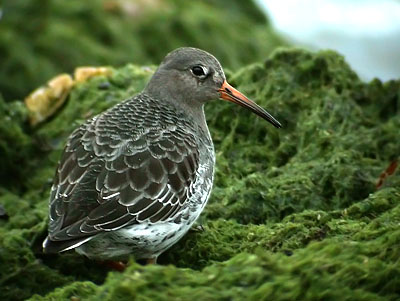
Purple Sandpiper at Sheboygan in 2002
This past Sunday, Seth and Noel Cutright witnessed a Merlin chase and capture what they believed to be a Purple Sandpiper at North Point, Sheboygan. Seth reported the observation to the Wisconsin Birding Network, "It was a good sized bird for a Merlin to take." Yeah, that's what I thought, too.
I made the trip up to Sheboygan with Kim and Corey Benton on Saturday and we were fortunate to find 3 Purple Sandpipers (as many as 5 were previously reported). I first spotted them flying over the water by the piers, then they came to rest on the rocky point next to the parking lot. The three birds briefly foraged, but soon went airborne again in favor of a spot further down the beach. We walked over and got excellent looks at them (life birds for both Kim and Corey). These were the first Purple Sandpipers I've seen in nearly 3 years.
The shorebirds were pretty skittish compared to the few other Purple Sandpipers I've seen in the past and recall thinking they would make an obvious target for a Peregrine Falcon. I have to admit I first read Seth's post with a bit of skepticism, as I've generally associated Merlin diet with large insects, rodents and small songbirds...but a shorebird as large as a Purple Sandpiper? I turned to Cornell's Birds of North America on-line for the answer:
"Diet on migration and wintering grounds poorly documented. Early studies based on stomach contents of migrating Merlins showed insects a large proportion of diet (Allen and Peterson 1936). Wintering Merlins feed heavily on various species of small shorebirds in areas where they are abundant; e.g., Least Sandpiper (Calidris minutilla) and Dunlin (C. alpina) each made up nearly 40% of the diet of Merlins wintering at Bolinas Lagoon (Page and Whitacre 1975; Buchanan et al. 1988). Urban wintering Merlins mainly feed on House Sparrows (72% of diet) and Bohemian Waxwings (17%; Warkentin and Oliphant 1990, see also Smith 1978, Servheen 1985). In Venezula (Hilty 2003), follows and feeds on large Dickcissel flocks found in some sections of the llanos (seasonally flooded grasslands)."
If a Merlin (10" in length) can take a Dunlin (8.5"), then it can take a Purple Sandpiper (9"). Fitzmier, you better get up to Sheboygan quick time. Those chubby rock-pipers are gonna be eaten!
Purple Sandpiper image © 2006 Mike McDowell

















